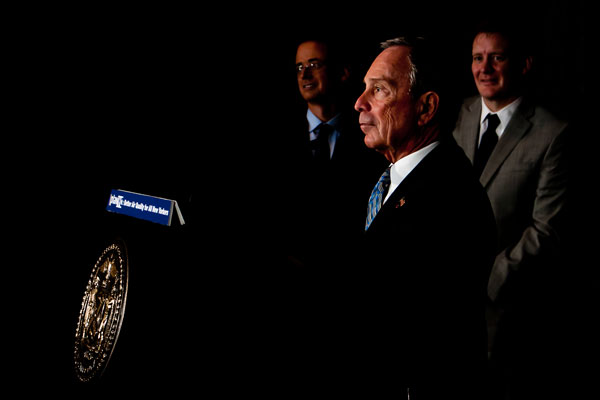
Photo by: Adi Talwar
The Bloomberg Administration welcomed New York City’s philanthropic sector in an unprecedented embrace with City Hall.
The Mayor’s Fund to Advance New York City and the Fund for Public Schools solicited millions of dollars in charitable and corporate contributions and it is no secret that the mayor himself used a small part of his immense personal wealth to augment the budgets of the City’s cultural institutions and to start new public private initiatives. City agencies, such as the Health Department created their own foundations with the encouragement of City Hall, and the Parks Department and the CUNY system stepped up their efforts exponentially to attract private dollars into our parks and public college systems.
Unlike Mayor Bloomberg, the next mayor will not be able to leverage his personal wealth to encourage others to give in support of his pubic goals. However, it would be a serious error for the next mayor to fail to thoughtfully engage with New York’s philanthropic sector, particularly during a time when the role of government keeps getting redefined downward, and we continue to face significant challenges that come with persistent poverty in many neighborhoods across the City.
The next mayor should not be a bystander while big philanthropy extends the scope of its interests and investments into the pubic policy arena – whether it be charter schools, healthcare and other safety net services, immigration reform, employment and training, environmental policy, criminal justice services or other critical areas.
Philanthropy has much to offer in its ability to take risks and its continuing investment in research and program development.
Clearly, public sector spending dwarfs the investments made by foundations and charitable individuals – the annual budget for the Department of Education is an astounding $25 billion. Philanthropy has been generous but its charitable giving is not in the same league.
Nevertheless, opening up fresh channels of communication and learning between the multi-billion dollar philanthropic sector and the new Administration in City Hall could make a real difference in addressing the challenges of income inequality, uneven educational achievements, and environmental issues related to climate change.
The next mayor has a chance to build on the Bloomberg philanthropic legacy and take it to an even deeper and more effective level.
For example, the Fund for Public Schools, an effort originally led by Caroline Kennedy, and currently invested with more than $30 million, was initially focused on funding former Chancellor Joel Klein’s NYC Leadership Academy, a project to help new principals learn best business and leadership practices. This charitable fund has continued to be used almost exclusively for mayoral and chancellor management initiatives, even at a time when many schools, principals and parents continue to search for ways to pay for the simplest school enrichment projects in culture, music, art, chess, robotics, sports, and environmental studies.
The recent film documentary “Brooklyn Castle” chronicled the highs and lows of a championship junior high school chess team in Williamsburg as the school struggles to raise the funds needed to send the students to national competitions in the face of annual budget cuts. Similarly, Michael Powell’s recent column in the New York Times about the potential loss of the Penny Harvest program in the schools highlighted the importance of being able to deploy private dollars for enrichment in less affluent
public school communities (after the story appeared, a last minute rescue came from the City Council).
Our new mayor should rethink the use of the Fund for Public Schools to include a mandate to provide technical support and matching dollars to help schools and parents raise money for neighborhood school enrichment programs. By allowing the Fund to utilize the full range of grantmaking tools like challenge or matching grants, and specifically setting aside donated funds for schools to use to attend national competitions, go on expeditionary learning trips, college tours, etc. the mayor would be taking an important first step in in leveraging the Fund for Public Schools to make a difference on a community level.
Similarly, the Mayor’s Fund to Advance New York City represents a very robust and muscular source of private corporate and philanthropic support for the City. It raised more than $40 million after Superstorm Sandy, and, a few years ago, it secured major funding support from environmentally focused foundations to advance the mayor’s contentious congestion pricing strategy. The Bloomberg Administration has demonstrated that this large private fund, once only used to pay for parades and public events, can be deployed to pay for significant needs in an emergency and to advance policy goals.
The new Administration should consider ways that it can use a Mayor’s Fund to focus on place based strategies in neighborhoods throughout the City to help advance the ideas and projects developed by local nonprofit leaders with the help of the philanthropic sector.
Investing in building a stronger social infrastructure around public housing developments, strengthening opportunities for access to cultural, educational and recreational activities, planning for greener healthier neighborhoods, and similar efforts could benefit from a partnership with the Mayor’s Fund.
The next mayor has a wonderful opportunity to build on Michael Bloomberg’s relationship with the philanthropic community by bringing a fresh, neighborhood-centric, community minded approach to giving. Whether it’s Joe Lhota or Bill de Blasio, he should make sure City Hall’s doors remain wide open to New York City’s unique and invaluable philanthropic sector. Aligning progressive public policy with thoughtful philanthropic strategies can help to build a more equitable and fair future for all New Yorkers.








